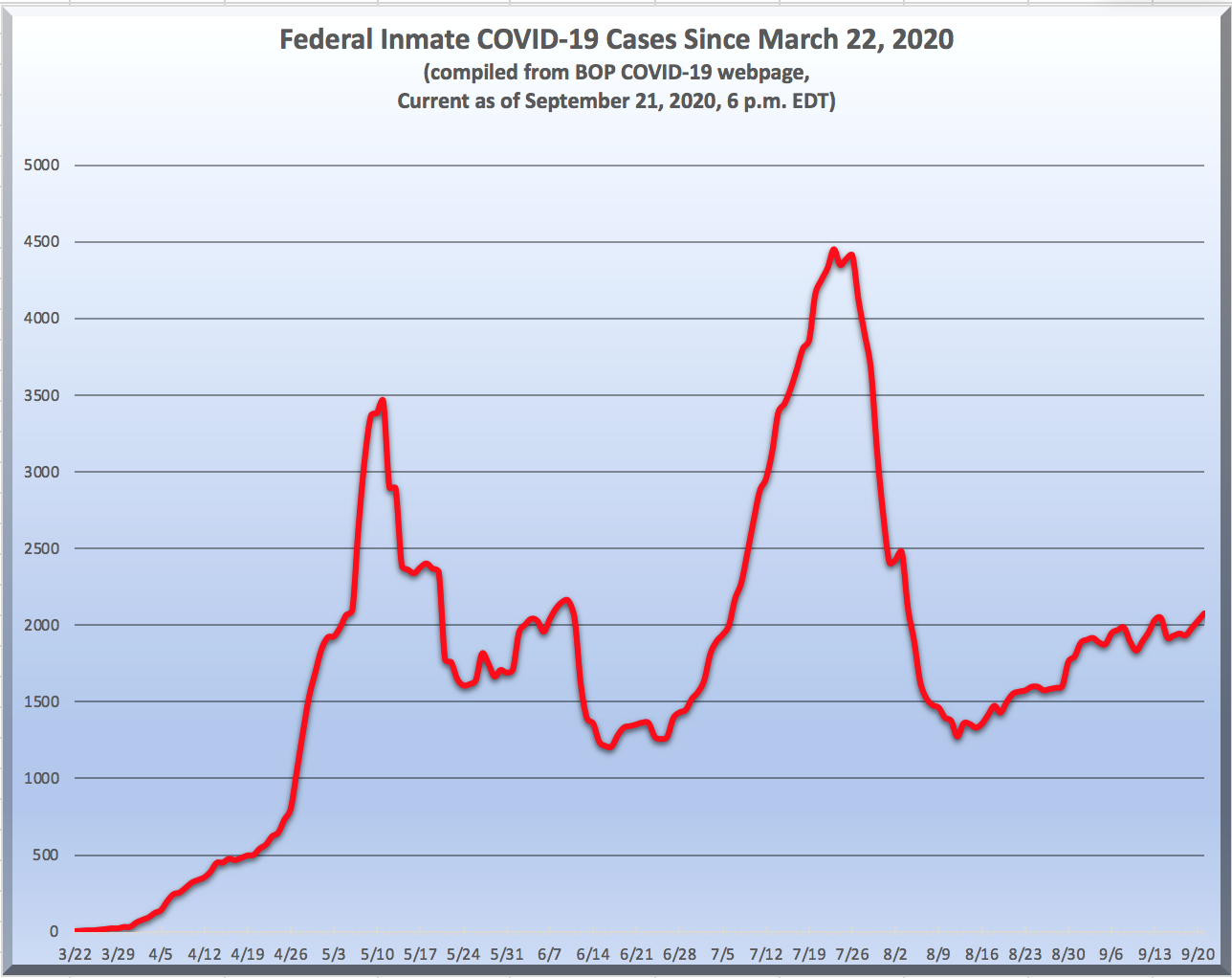We post news and comment on federal criminal justice issues, focused primarily on trial and post-conviction matters, legislative initiatives, and sentencing issues.

COVID-19: NEW REASONS TO BE VERY AFRAID
The Federal Bureau of Prisons once again gained nothing last week in its fight against COVID-19. The number of inmates sick with the hovered all week between 1,915 and 2,045, and last night, hit 2,076. The number of sick staff started climbing again, too, from 631 a week ago to 669. The number of BOP facilities with the virus climbed as well to 117, a whopping 95% of all institutions. Ominously, the number of dead inmates jumped from 125 to 130.
The increase is consistent with concerns that the nation is in for another coronavirus increase in the coming days. And just in time for the fall spike.
The BOP has done enough COVID-19 tests as of last night to test 37% of the BOP inmate population. The percentage of tests that are positive remains 25%.
One of last week’s deaths is especially troubling. On June 1, FCI Butner inmate Ricky Miller tested positive for COVID-19. A month later, he was tested again and declared to be recovered. Two months later, on Sept 9, Ricky developed shortness of breath and leg edema, and was hospitalized. The hospital found that he had COVID-19. He died a day later.
The timing suggests that Ricky caught COVID twice within a few months. If that is so, then the idea that having the disease once confers immunity against getting it again is cast into doubt. And that could mean that COVID-19 will remain a risk until a vaccine is available for inmates.
This comes as new research released last week suggests that the coronavirus can sometimes hijack brain cells, using the cells’ internal machinery to copy itself.
The research, which has not yet been published in a peer-reviewed journal, provides evidence that the virus can directly infect neurons. Although the coronavirus has been linked to various forms of brain damage, from deadly inflammation to brain diseases known as encephalopathies, all of which can cause confusion, brain fog and delirium, there was little evidence of the virus itself invading brain tissue until now.
 Scientists at Oak Ridge National Labs in Tennessee announced last week that supercomputer analysis of COVID-19 suggests that the virus triggers a “bradykinin” storm in the body. Bradykinin is a chemical that regulates blood pressure. The researchers found that some people with the coronavirus may produce it in extreme excess, according to Business Insider, throwing major systems — including respiratory, gastrointestinal, and neurological pathways — off balance.
Scientists at Oak Ridge National Labs in Tennessee announced last week that supercomputer analysis of COVID-19 suggests that the virus triggers a “bradykinin” storm in the body. Bradykinin is a chemical that regulates blood pressure. The researchers found that some people with the coronavirus may produce it in extreme excess, according to Business Insider, throwing major systems — including respiratory, gastrointestinal, and neurological pathways — off balance.
 The theory aligns with researchers’ growing view of the coronavirus as a vascular disease instead of a respiratory one. Research has shown that COVID-19 can lead to blood clots, leaky capillaries, and inflamed blood vessels — which is why some patients may experience heart damage or stroke. “We were really scratching our heads for a while, how does this disease have this darn broad set of symptoms across lots of different organ systems?” Dr. Daniel Jacobson, the lead researcher behind the supercomputer study, told Business Insider. “As we looked at the effects of bradykinin, our model was that this virus can affect several different types of tissues, several different organs.”
The theory aligns with researchers’ growing view of the coronavirus as a vascular disease instead of a respiratory one. Research has shown that COVID-19 can lead to blood clots, leaky capillaries, and inflamed blood vessels — which is why some patients may experience heart damage or stroke. “We were really scratching our heads for a while, how does this disease have this darn broad set of symptoms across lots of different organ systems?” Dr. Daniel Jacobson, the lead researcher behind the supercomputer study, told Business Insider. “As we looked at the effects of bradykinin, our model was that this virus can affect several different types of tissues, several different organs.”
Meanwhile, the BOP faces new eruptions of COVID-19 at USP Leavenworth, as well as continuing crises at Big Spring, San Diego, Coleman, Waseca and Manchester.
BOP, Inmate Death at FCI Butner (Low) (Sept 17)
Livescience, The new coronavirus can infect brain cells, study finds (Sept 13)
Business Insider, A supercomputer found a promising theory about why COVID-19 cases go downhill fast. It even explains the bizarre range of symptoms (Sept 13)
Hays, Kansas, Post, Leavenworth tops all federal prisons in COVID-19 cases (Sept 15)
– Thomas L. Root


